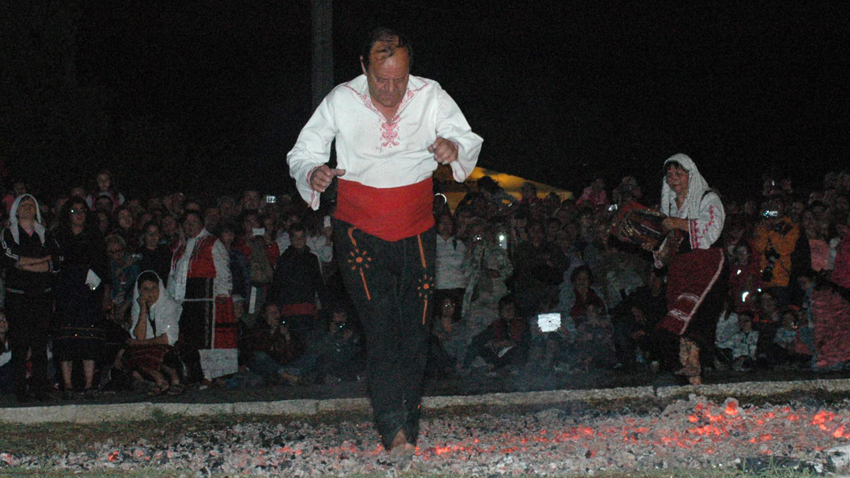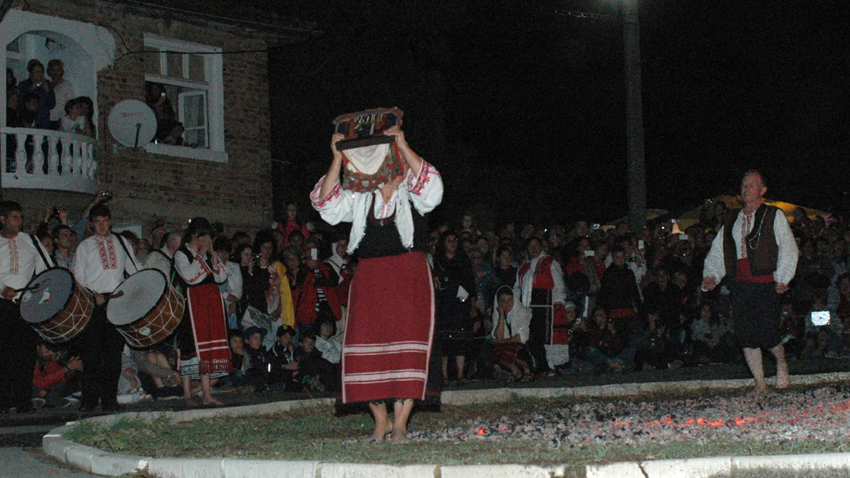People from the Strandja village of Bulgari regard June 3 as a date that is almost sacred. Thousands throng to this pretty little village each year to experience the magic of one of the oldest and most mysterious rituals in Bulgaria, called "nestinarstvo" or dancing barefoot on live embers. It is one of the most spectacular and astonishing religious practices in this country. The "nestinarstvo" tradition is on the UNESCO List of Intangible Cultural Heritage. There are only five villages in the country where this ancient ritual is still practiced, all of them in Mount Strandja – Kosti, Kondolovo, Gramatikovo, Slivarovo and Bulgari. The ritual was first documented in 1862 by writer Petko R. Slaveikov.
The people of Bulgari observe the tradition of performing the entire ritual on the date designated – June 3, the day of St. St. Constantine and Helena according to the old calendar. The pagan tradition, passed down for generations, is interwoven with Christianity via the legend of the two saints. The trance-like fire dance of the nestinari to the sound of beating drums is unique for Europe. And it is only the initiated ones, people in whom the spirit of St. Constantine lives that can dance on the burning embers, whispering incantations for health and forgiveness and sometimes even prophecies. Vesselina Ilieva is perhaps the oldest nestinar dancer in Bulgaria, who says that even though Strandja is the cradle of the mysterious ritual, there are initiated people in other parts of the country as well.

“Strandja is not the only place they can be seen, there are people dancing on live embers everywhere. But they dare not come here, because Bulgari is the place where it all begins – one needs to be admitted and capable of dancing in this big fire.”
Vesselina Ilieva steps onto the burning embers every year. It was only at the age of 40 that, all of a sudden, she started fire-dancing. At the time she was singing with a Strandja folk band. One time she felt faint during the nestinari ritual in Bulgari. A doctor came but was stupefied - her pulse and blood pressure were normal but her entire body was freezing. But an old nestinar woman came and said that she “was possessed” – that was how the initiated ones were described in Strandja. Vesselina has been entering the fire year after year ever since. The fire-dance takes place after sunset and the dancers wear white shirts. Everything is still and only the monotonous beating of the drum rolls over the surrounding hills. The nestinari dance around the fiery circle holding icons and all of a sudden step onto the burning embers. Their bare feet come in contact with the fire, as if guided by the power of the saints depicted. Sometimes their feet barely touch the ground, other times thet step hard on the embers and put the fire out. Their faces are pale and their eyes – half-closed, as if their mind is wandering.
“Fire is not something that can be overcome – you either walk in it or you don't,” says the youngest nestinar Georgi Iliev. “It is simple – the self-assurance inside you must be be greater than your fear. Fear is something you have to cope with. You must clear your mind and forget about the world outside.”

Georgi is 32 and is heir to a nestinar dancer - he was raised on the mystery of the ritual, passed on from one generation to the next as a family tradition.
“The tradition of nestinari dancing lives on. But because of the persecution, mostly by the church, which at first rejected it as a non-Christian ritual the tradition was interrupted in our village. But in time the older people restored it and we hope that the tradition won’t be interrupted in our day.”
Georgi says that the nestinari of old could "feel" who would continue the tradition. “One must feel it in one’s soul,” his grandma Milka says.
“If I have the faith inside, I enter the fire… One should have faith – faith is what helps you keep the rhythm.”
The nestinari festival in Bulgari starts in the morning when the icons are taken out of the local St. St. Constantine and Helena Church. The procession, to the sound of the rhythm typical of the nestinari melodies, reaches Vlahov Dol, a locality held sacred by the nestinari. There the icons are sanctified with water from the sacred spring and a ritual chain dance is performed. The fire is started early in the afternoon, so it will be ready for the mystic ritual of fire dancing in the evening.
English version: Zhivko Stanchev
Edited in English by Milena Daynova
Photos: BULFOTOThere are no data regarding the exact number of Bulgarian dance ensembles operating abroad. But there is one thing that is certain – they are amateur groups scattered across all continents, acting as a bridge between Bulgaria and the rest of the..
Bulgaria's Pernik will host the 44th annual meeting of the Federation of European Carnival Cities , which is opening today , the municipal administration announced. More than 100 delegates from 20 countries are expected to elect a new president and new..
Eight days before Easter, we celebrate Lazarus Saturday (St. Lazarus Day). It is the first of the three major Christian feasts associated with the miracle of the Resurrection and is followed by Palm Sunday and Easter. St. Lazarus Day is celebrated..

+359 2 9336 661
